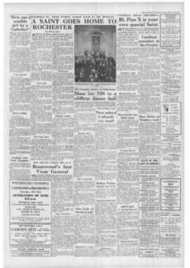Page 3, 28th May 1954
Page 3

Report an error
Noticed an error on this page?If you've noticed an error in this article please click here to report it.
Tags
Share
Related articles
.1■lcuin On The Latest B01111‘n
Christian Unity
Goes Begging With A Film
A11,11 1 11 Ia On 'hp Latest Books
Christian Unity Week
Dr. Sangster • on the art of preaching
THE CRAFT OF THE SERMON, by W. E. Sangster, M.A., Ph.D. (Epworth Press, 9s. 6d.).
AN INTRODUCTION TO THE INNER LIFE, by the Rt. Rev. Lutnsden Barkway, D.D. (Mowbray, 65.).
By Dom Bede Griffiths, 0.S.B. nR. SANGSTER, a well-known L./Methodist preacher, has here gathered into one volume two previously published books on the art of preaching. They are extremely practical and there can be few priests who have to preach a sermon regularly who would not find something to learn from them.
One is glad to see the insistence at the beginning that the sermon is essentially "sacramental," a "ministry of the Word," and not a mere human address. The division of subject matter into Biblical interpretation, ethical and devotional, doctrinal, philosophic and apologetic, social and evangelistic, shows the wide range which is covered, and the study of different methods of presentation is no less comprehensive.
The ethos of the book is naturally that which belongs to the author's own communion, but it is the work of a man with a very wide experience of preaching anti a strong and sincere personal religion.
There is a quotation from St. Fiemadino of Siena on page 200 maintaining that the hearing of the sermon is of more value to the soul than the hearing of Mass: one would like to know more about the evidence of this very doubtful theology.
Inner Life THE "Introduction to the Inner Life," by a former Episcopalian Bishop of St. Andrews is intended as a practical guide to the beginner in the life of prayer.
It is abundantly illustrated with quotations from the most diverse writers, ranging from Socrates and St. Augustine to Mr. Gerald Heard and Middleton Murry, but it is nevertheless soundly traditional in its approach.
The Threefold Path, corresponding to the "three ways" of the spiritual life, is characterised as the path of repentance, faith and love; and the Threefold Regime is that of the evangelical counsels of poverty, chastity and obedience.
It is characteristic of the author's point of view that obedience is given first to one's own inner inspirations, then to the "fact of Christ," that is the general message of the Gospel, and finally to the "consensus fidelium." The idea of St. Ignatius that obedience is given to a superior who represents Christ is not accepted.
A chapter on the inner life and the Sacraments helps to relate prayer to the Eucharist, and in the final chapters an approach is made to contemplative prayer, following for the most part the traditional Catholic lines.
blog comments powered by Disqus











